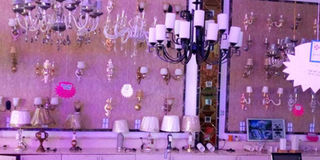Fake electric appliances could cost you

Most fake electrical equipment look like genuine ones. Photo by Beatrice Nakibuuka
What you need to know:
- Many people cannot tell the difference between fake and genuine electrical appliances because they sometimes look the same.
With online shopping becoming increasingly popular, it is becoming easier for people to purchase fake goods both knowingly or accidentally. There are very many counterfeit products on the market, especially electrical home appliances which are hard to detect. Many home electric appliances, phone and chargers and cables are sold and surprisingly at the same price or higher than the genuine products.
The real cost
You may be wondering why your electricity bill is always high and get frequent short circuits or your bulbs keep blowing out. According to BK Patel, CEO Hi-Tech Industries, the reason could be that the appliances or cables you used in your home electric system are counterfeit and substandard.
Patel says: “Fake PVC pipes, cables and accelerators can accelerate fire outbreaks in case of a short circuit because the circuit breakers are nonfunctional and the main switch will not stop the current from flowing which leads to total burning of all things that may be in the house.”
He adds that using fake cables can cause explosion in mobile phones and, according to Patel, can lead to death. “Counterfeit products are typically at a lower cost, have substandard design, materials and of poor quality. Consequently, the likelihood that a counterfeit electrical product could malfunction is much higher.”
These products often lead to shock, burns, fires, explosions, and incidents that can cause property damage, injury, or death. Steven Muwanguzi, a supervisor at Kampala Electric Mart, says sockets and lamp holders that make a sparking noise when on indicate that the cable or appliance is fake. These often cause electric shock, blowing up of bulbs and phones. “Counterfeits are often not effective and efficient and will only be used for a short period of time and the homeowner will have to replace them time and again. They lead to increased power consumption in the home and increased cost for repairs because most counterfeit sockets melt away.”
How do you know?
Identifying fake from genuine electric products may be difficult by just a mere look at them but if you walk around town, you will see vendors selling things like extension cords, power strips and night lights at incredibly low prices. Charles Kisame, the quality control manager at Chint Electricals says the price could be too good to be true and the product is likely to be counterfeit.
A genuine product manufacturer wants the consumer to get value for the product they are buying but if your home appliance retailer does not provide a guarantee for the product, it could be obvious that the product is not genuine. No guarantee is a way of dodging consumers that may want return the product if it did not satisfy the need. If they trust the durability and functionality of the appliance, they should grant you a guarantee.
Kisame says: “Although labelling is part of marketing, many fake products do not have labels and surprisingly people buy them. The packaging of fake products is often not clear and may only have stickers on the packaging.”
You could have bought or used the counterfeit electric product but if the light switches feel warm when you touch them or make a sparking, buzzing, cracking or sizzling sound when you switch on, you need to call a professional electrician immediately to see if your wiring needs repairs or should be replaced.
The way out
Check out for the national or international standards certification so that you are sure about the originality of the product. Do clear research on the internet about the best products and how to identify them before you buy them. “The best way to protect yourself from counterfeit electrical products is to buy from reputable retailers who are established dealers and you know where to find them just in case the appliance did not work the way you expected it to,” says Muwanguzi.
Check to make sure the product bears a seal and the voltage of the products.




